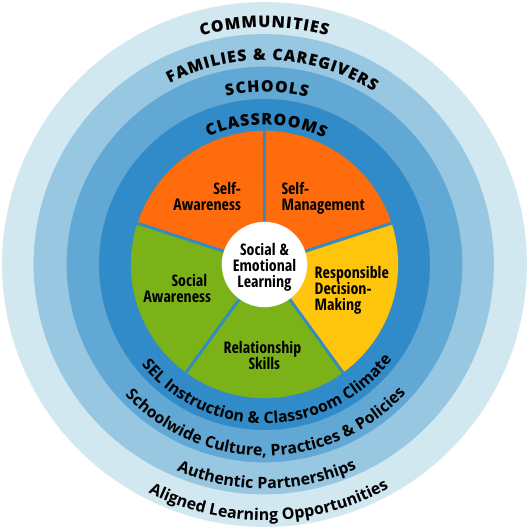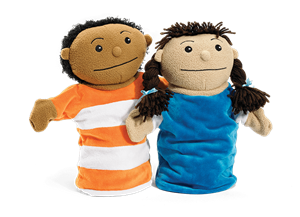- Prairie Children Preschool
- Social Emotional Learning (SEL)
Instruction
Page Navigation
-
Social Emotional Development
At Prairie Children Preschool, we incorporate several different social-emotional evidenced based practices in order to begin teaching children lifelong skills that will create a foundation for pro social behavior that will lead to being a good student, citizen, and worker; and many different risky behaviors (e.g., drug use, violence, bullying, and dropout) can be prevented or reduced when multi-year, integrated efforts develop students’ social and emotional skills.
PBIS – Positive Behavior Interventions and Supports
PBIS is a school-wide decision making framework that guides selection, integration, and implementation of the best evidence-based academic and behavioral practices for improving important academic and behavior outcomes for all students. The underlying theme is teaching behavior expectations in the same manner as any core curriculum subject. Our preschool focuses on three behavioral expectations that are positively stated and easy to remember which are: Be Ready, Be Respectful, and Be Safe. In other words, rather than telling students what not to do, the school focuses on what the expected behaviors are within the classroom. The application of this school-wide approach will then likely show a decrease in problematic behavior for students, increase academic performance, increase safety and established a positive school culture.
Check out the dropdowns below to learn more!
-
WHAT IS P.B.I.S.? BE READY - BE RESPECTFUL - BE SAFE
You might be hearing or seeing things around the Preschool that are related to our positive behavior supports and expectations. We thought that you might be interested in becoming familiar with some of the basics of this initiative.
What is P.B.I.S. (Positive Behavior Interventions & Supports)?
P.B.I.S. is a school-wide process that organizes adults and students to create a social culture in the school that will encourage positive behavior and interactions, while discouraging problematic behaviors. Hopefully, this will lead to a safe environment where students achieve academically and build positive relationships with each other and with adults. The process focuses on expectations, rather than rules.
What are the school wide expectations for the Preschool?
Our school wide expectations are: Be Ready, Be Respectful, and Be Safe.
How are these school wide expectations taught at the Preschool?
These expectations are presented to the children in a variety of age appropriate activities that define, teach, and remind students in an encouraging and positive way. Positive behaviors are celebrated as a classroom throughout the year.
How can you help promote these school wide expectations?
Use the common vocabulary of ready, respectful and safe when talking with your child at home. Use language that lets your child know that you accept them, know that they can accomplish things, and that you appreciate them. Remember to let your child know when they have demonstrated being ready, respectful and safe by using praise and encouragement. Children learn from watching others. Let’s all try to be good models for our children.
For more information about P.B.I.S. (Positive Behavior Interventions & Supports) visit:
-
“BE READY”
Children do best when they know what to expect. The expectations we have for our Preschool students are to Be Ready, Be Respectful and Be Safe. The expectations are a part of our school wide Positive Behavior Intervention Strategies (P.B.I.S.) Program. With the expectation of being ready, students are able to prepare themselves to learn and maintain their focus when learning.
What We Teach At School
At school, some ways we encourage children to Be Ready are:
- Eyes on the teacher when she is talking.
- We are quiet when someone else is speaking.
- Our hands and feet are quiet, too.
- We make sure that we are ready when it’s time to go leave the room (coats and backpacks on, hands to self …).
When we see them “being ready”, we acknowledge it by saying things like “I like the way you are sitting quietly in circle. You are ready to listen.” We make sure to let the child know that their positive behavior was recognized in hopes that it will encourage the child to do it that way again.
What You Can Do At Home
At Home, you can promote being ready within your family. It is important for children to practice behaviors across all their environments. Some ways you can encourage your children/family to be ready are:
- Give children a realistic expectation for leaving the house (shoes on, coat on, T.V. off ..) and an verbal reminder of when you will be leaving (“We will be leaving the house to go shopping in a few minutes. You need to be ready to go soon.”)
- Develop predictable daily routines for bedtime and bath time. If children know what to expect, it will help them to be ready for these sometimes challenging times.
- Help your child be ready to exit the car in carpool or individual drop-off. Make sure their coat is zipped and their backpack is on.
Remember to recognize your child for their positive behaviors by telling them that you like the way they were being ready. If you see that your child is having difficulties with being ready in certain situations, help them to get themselves ready and remember to use the word “ready” when you are doing so. For example, “Tommy, I need you to get ready to go to the bus. You need your coat and your backpack on – then I’ll know that you’re ready.”
-
“BE RESPECTFUL”
Respect can seem to be a “big” word for a preschooler to understand. If you really think about it, respect like safety is a feeling created when certain actions are performed. It’s never too early to starting teaching children positive behaviors. When those behaviors are paired with the word respectful, children can learn that “big” word sooner than you think.
What We Teach At School
At school, some ways we encourage the children to Be Respectful are:
- Listening when the teacher is talking
- Using polite language like please and thank you
- Using the classroom materials carefully and properly
When we see them “being respectful”, we let them know that we noticed by saying things like “I like the way you waited your turn to talk. That was being respectful.” We make sure to let the child know that their positive behavior was recognized in hopes that it will encourage the child to do it that way again.
What You Can Do At Home
At home, you can promote respect within your family. It is important for children to practice behaviors across all their environments. Some ways you can encourage your children/family to be respectful are:
- Responding to a greeting from a family member or neighbor
- Using family member’s proper names
- Asking before you use a sibling’s belongings
Remember to recognize your child for their positive behaviors by telling them that you liked the way they were being respectful. If you observe you child being disrespectful, tell them to stop or encourage another behavior but remember to use the word respectful in you explanation. For example, “Suzie, I need you to stop calling your sister names. It’s not respectful.”
When a person shows respect to others, they will also earn respect back. When a child earns that sense of being regarded, it positively affects their self-esteem. Parents and teachers want children to be confident learners who are successful at and respected for whatever they do! -
“BE SAFE”
At Prairie Children Preschool, we practice PBIS or Positive Behavior Interventions & Supports. Part of this is having “expectations” and our expectations are Be Ready, Be Safe and Be Respectful. We talk about these concepts as “action words” because you have to do something or demonstrate a behavior to achieve that expectation. By promoting the expectation, Be Safe, we are trying to create an environment where the children feel they are free from danger or injury because the behaviors we’re promoting for Be Safe are designed to prevent accidents.
What We Teach At School
At school, some ways we encourage the children to Be Safe are:
- Stay with the class in line when walking through the hallways or outside the building
- Keep our hands and our feet to ourselves
- Climb the playground equipment near teachers
- Go down the slide one child at a time with feet first
When we see them “being safe”, we let them know that we noticed by saying things like “I like the way you went down the slide with feet first. That was being safe.” We make sure to let the child know that their positive behavior was recognized in hopes that it will encourage the child to do it that way again.
What You Can Do At Home
At home, you can promote being safe with your family. It is important for children to feel safe across all their environments. Some ways you can encourage your children/family to be safe are:
- Staying with/near you at the grocery store
- Holding your hand when crossing the street
- Certain activities like using the stove are only for adults
- Wearing helmets when riding bicycles or scooters
You could make it a family activity to come up with a list of safety rules. Remember to recognize your child for their positive behaviors by telling them that you liked the way they were being safe. If you observe you child engaged in an unsafe activity, tell them to stop but remember to use the word safe when you are explaining why they need to stop. For example, “Johnny, I need you to stop climbing on the chair like that. It’s not safe.”
If both parents and teachers encourage safety, it might just become part of the children’s daily routine!
-

Rings from center out: Social & Emotional Learning; Self-Awareness, Self-Management, Social Awareness, Relationship Skills, Responsible Decision Making; Classrooms/ SEL Instruction & Classroom Climate; Schools/Schoolwide culture, practices, & policies; Families & caregivers/Authentic partnerships; Communities/Aligned learning opportunities.
Second Steps
What is Second Steps?
Second Step® social-emotional learning (SEL) programs empower preschoolers, teens, and all ages in between to build skills for success. Choose from a cohesive family of research-based programs that work together to provide SEL throughout students’ developmental stages, and in both classroom and out-of-school time settings. In addition, our professional development program for educators brings the benefits of SEL to your staff and school culture, so everyone can thrive.
How is the Second Steps program implemented?
-
28 weeks of learning using storyboards, songs, brain builders, puppets, and home links to help facilitate the students’ learning.
-
Home links go home each week to facilitate the home to school connection with Social/Emotional Learning.
Meet our Second Steps puppets, Jack and Jill!

-

